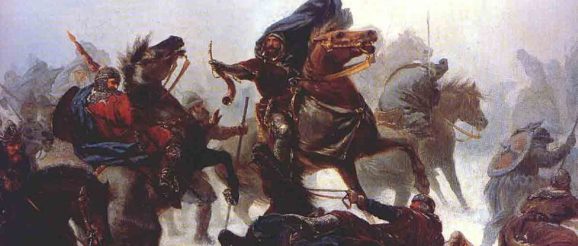The Obvious Innovation in Fifth-edition Dungeons & Dragons That No Designer Saw Before

Stirrups. Zero. Shipping containers. Luggage with wheels. All these innovations seem obvious in hindsight. But they went undiscovered for millennia, until someone’s bright idea changed the world—or at least put airport porters out of work. Even those hotel shower rods that curve made someone rich.
Fifth edition Dungeons & Dragons includes one obvious-in-hindsight innovation that the game’s past designers failed to spot. Alas, it won’t make anyone rich.
Up until fourth edition, D&D fighters gained extra attacks, but fourth edition avoided them. The designers shunned extra attacks partly to speed play by reducing the number of attack and damage rolls. Sure, spells attacked lots of targets, but at least spells only required one damage roll.
Also, fourth edition, like all earlier editions of D&D, aimed to parcel out benefits smoothly as characters leveled up. In theory, this made the difference in power between, a 4th- and 5th-level character about the same as the difference between levels 5 and 6. Characters at similar levels could adventure together without someone routinely dealing twice as much damage. But a second attack on every turn brings a fighter a big jump in power.
The designers of past editions worked to smooth these jumps in power by granting fighters something less than a full, extra attack. AD&D gave fighters extra half attacks, and a need to remember half attacks. Third edition traded half attacks and the memory issue for weaker attacks and fiddly attack penalties. These solutions complicated the game with awkward memory demands and calculations.
So playtest versions of fifth edition did not grant fighters and other martial characters an Extra Attack feature. Rather than gaining more attacks, these classes earned features that enabled attacks to deal more damage. But this approach put fighters at a disadvantage against weaker foes easily dropped by a single blow.
When a fighter confronts a goblin horde, and only makes one attack per turn, no amount of extra damage matters, because one strike can only fell one goblin per turn. To help martial types against weak foes, the playtest included cleaving-attack powers that swept through groups. But such features failed to remedy another trouble: To-hit bonuses in fifth-edition increase at a slower rate and never grow as big as in earlier editions. The designers call this bounded accuracy, because they do not come from marketing. Bounded accuracy means that fighters hit weaker foes less easily than in past editions.
Fighter types should hew through the rabble like grass until, bloodied and battle worn, they stand triumphant. But in the playtest, even the mightiest spent turns muffing their one attack against some mook. With an extra attack, misses matter less because there’s more where that came from.
During the playtest, I wrote, “If D&D Next’s designers can find a good way to allow fighters to gain multiple attacks against weaker opponents, then a key piece of the Next design puzzle falls into place.”
Late in fifth edition’s creation, the designers compared the benefits each class gained as they leveled and noticed that wizards leap in power at 5th and at 11th levels. These jumps come from quirks of a spell list that date to the beginning of the game. At 5th level, wizards gain potent attack spells like Fireball, plus unbalancing buffs like Haste. At 11th level, wizards gain 6th-level spells, which bring save-or-die effects like Disintegrate. At the 9th spell level, Gary Gygax felt comfortable stashing world-altering spells like Wish and Time Stop, because his players never reached 17th level and never gained easy access to them.
Earlier editions of D&D aimed to parcel out benefits smoothly as characters leveled up. Those edition’s designers ignored the leaps in power certain spells brought; the fifth-edition designers embraced the leaps.
This brought the obvious-in-hindsight innovation: Rather than offering fighters half attacks or fiddly attack penalties, fifth edition matches the leaps in power brought by additional attacks to the leaps brought by 3rd, 6th, and 9th-level spells. Fighters gain extra attacks as wizards gain these spells. At the same levels, other classes gain potent powers and spells of their own. For instance, the bard’s Hypnotic Pattern spell got a fifth-edition redesign that moves it to 3rd level and dramatically increases the spell’s power.
Third and fourth editions arbitrarily aligned the game’s tiers with 10th and 20th levels, because of round numbers. The fifth-edition tiers match to the levels where characters gain the best new powers and spells. These leaps in ability mean 4th- and 5th-level characters cannot adventure together without displaying big power differences, but characters in the same tier can join a party and contribute.
It all seems obvious now. Designer Mike Mearls says that a lot of innovations in game design work that way.
